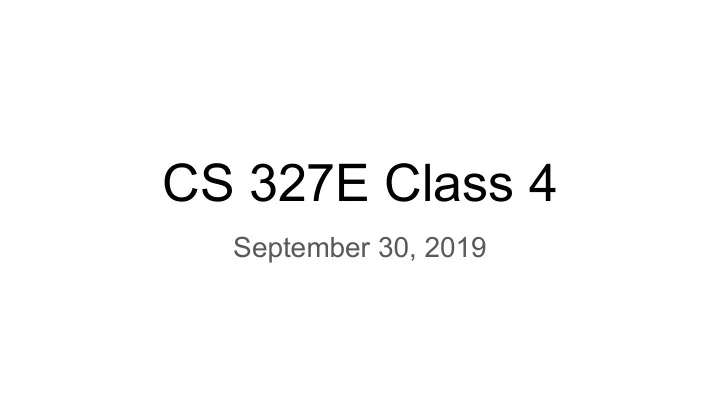

CS 327E Class 4 September 30, 2019
1) What type of relationship do we have between the Actor and Movie entity types as shown? A. 1:1 B. 1:m C. m:n
2) How many joins would we need to find the cast members who acted in 'Avengers: Endgame' and return their name and age? A. 1 B. 2 C. 3
3) Which of the following concepts is not specified by the ER model / ERD? A. Attribute Types B. Key Attribute Types C. Attribute Type Domains D. None of the above
4) Which of the following is an example of a generalized entity type? A. Customer is a generalization of Person B. Artist is a generalization of Painter C. Concert is a generalization of Music Event D. None of the above
5) Which of the following is an example of a specialized entity type? A. Midterm is a specialization of Exam B. Student is a specialization of Teacher Assistant C. Article is a specialization of Book D. None of the above
Review Terminology ● Entity: An object or a thing ● Usually a noun ● Common Examples: Person, Team, Product, Sales Order Analogies with OOP: ● Entity: analogous to Object ● Entity Type: analogous to Class Questions: ● What are the boundaries? ● How to handle hierarchies?
Design Principles ● A table models one Entity Type and an Entity Type is modeled by one table ● Each field in a table represents an attribute of an entity ● Each field in a table is assigned a strict primitive data type ● Each table has a Primary Key (PK) which is made up of one or more fields ● Each child table has a Foreign Key (FK) that points to its parent(s) ● Each m:n relationship is modeled with a junction table
Design Principles and College Dataset: How many violations can you find?
Design Principles and College Dataset: What can go wrong: data anomalies ● Insert Anomaly ● Update Anomaly ● Delete Anomaly
Common SQL Transforms ● CREATE TABLE T2 AS SELECT … ● SELECT a, b, c FROM T1 UNION ALL SELECT d, e, f FROM T2 ● SELECT a, b, c FROM T1 UNION DISTINCT SELECT d, e, f FROM T2 ● SELECT CAST(xyz AS DATE) … ● SELECT SAFE_CAST(xyz AS DATE) …
Data Modeling Demo
Practice Problem Student(sid, fname, lname, dob) Class(cno, cname, credits) Construct a SQL query that finds Teacher(tid, instructor, dept) all Takes records which violate Takes(sid, cno, grade) referential integrity with its parent Teaches(tid, cno) table Class.
iClicker Question Student(sid, fname, lname, dob) Class(cno, cname, credits) Construct a SQL query that finds Teacher(tid, instructor, dept) all Takes records which violate Takes(sid, cno, grade) referential integrity with its parent Teaches(tid, cno) table Class. What type of join is needed by this query? A. Inner join B. Outer join C. Self join
Normal Forms 1NF: A database schema is in 1NF iff all attributes have scalar values. 2NF: 1NF + all non-key attributes Functional Dependencies: must be functionally determined by If two records agree on the attributes the entire primary key. A 1 , A 2 , … , A n then they must also agree on the attributes B 1 , B 2 , … , B n 3NF: 2NF + all non-key attributes must be functionally determined by Formally: only the primary key. A 1 , A 2 , … , A n → B 1 , B 2 , … , B n
Normal Form Violations
Normal Form Violations
Model the semester of a Class Practice Problem without violating normal form
Is this a correct representation? iClicker Question A. Yes B. No
Milestone 4 1) Requirements: assignment sheet 2) Data modeling questions: sign-up sheet
Step 1: load CSV files into staging area in BQ as separate tables. Table Details: 2015 table: 241 MB size, 618,804 rows 2016 table: 233 MB size, 647,852 rows 2017 table: 253 MB size, 624,650 rows 2018 table: 283 MB size, 654,162 rows
Step 2: - read the documentation on your dataset (file descriptions and individual field descriptions). - identify the various Entity Types within and across your staging tables.
Step 3: create new modeled tables using CTAS statements. Referenced Code: https://github.com/shirleycohen/h1b_analytics/blob/master/h1b_ctas.sql
Step 4: create new ERD for modeled tables.
Recommend
More recommend